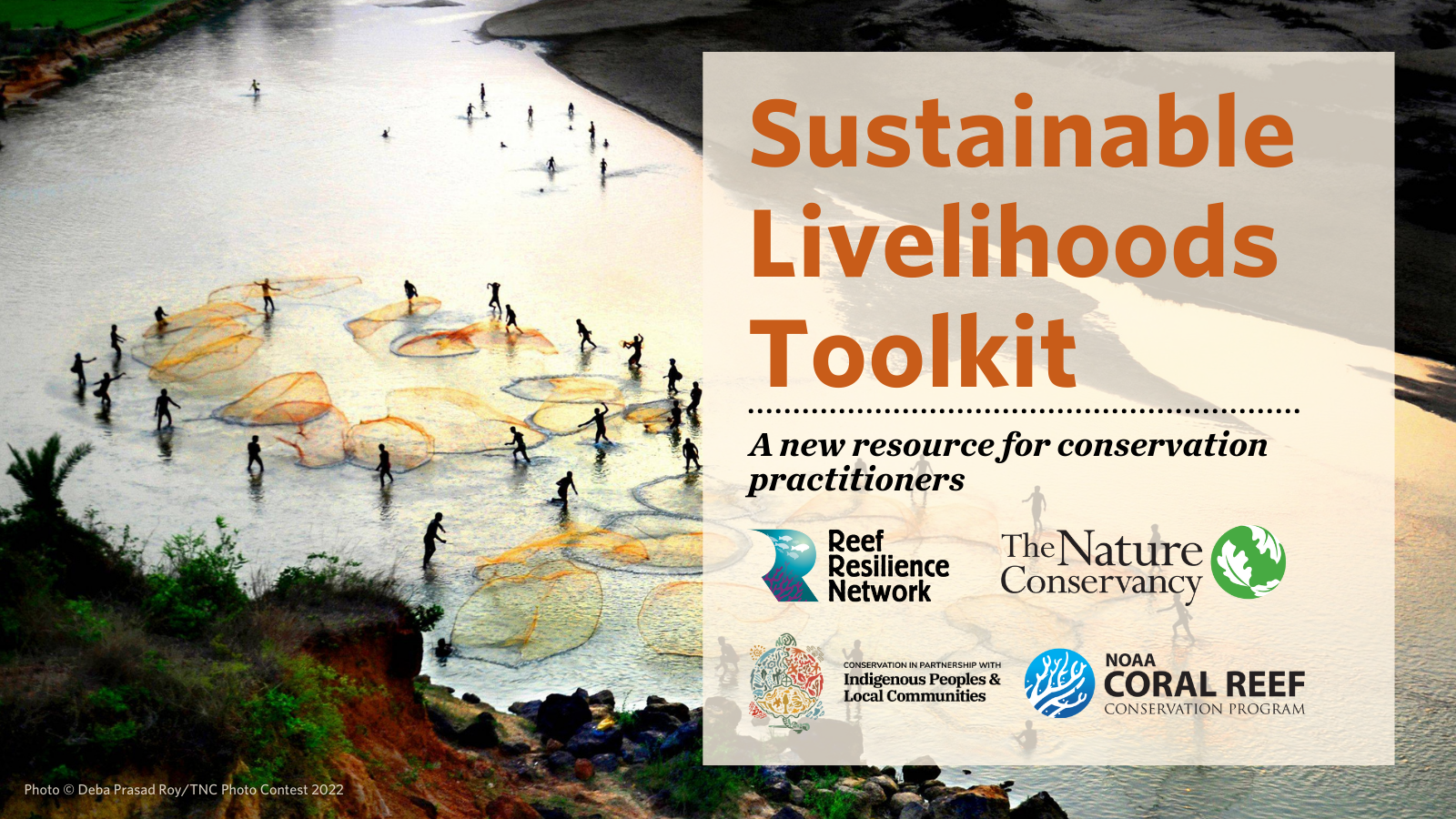Sanitation in Challenging Environments: The HandyPod
Location
Tonle Sap Lake, Cambodia and Lake Indawgyi, Myanmar
The challenge
Many factors influence where sanitation infrastructure is, or is not, suitable. Lakes, floodplains, mangroves, clay soils and beaches are impacted by human waste. In Tonle Sap Lake and Lake Indawgyi, in Cambodia and Myanmar, respectively, floating villages and stilted houses in the seasonal floodplain present challenges for sanitation. Wastewater treatment plants, septic tanks, and pit latrines are not viable options for protecting people and the environment from sewage. As a result, although both lakes are designated World Heritage and Biosphere Reserves, no prior sanitation effort has existed to combat sewage pollution or change local behaviors in this challenging sanitation environment.
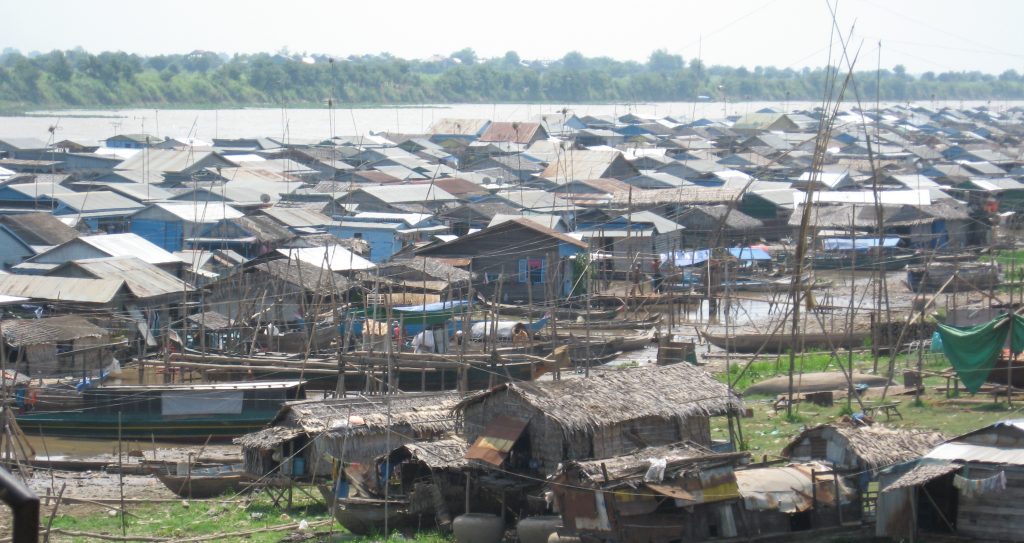
A floating community on Tonle Sap Lake, Cambodia. Photo © Wetlands Work
On Tonle Sap Lake, 20,000 houses float in shallow water. During the 6-month dry season, as the lake’s level drops, lack of sanitation infrastructure causes the village water to become contaminated, odorous, and dangerous (pathogen concentrations reach 30-40,000 cfu/100 mL). Nearby, 200,000 stilted homes sit on seasonal floodplains, contributing to and intensifying the consequences of open defecation. The resulting fecal pollution – pathogens and biological oxygen demand (BOD) – threatens biodiversity, human health, livelihoods, and the economy of these areas. Intestinal illnesses and childhood stunting are commonly experienced in the Tonle Sap community, exhibiting the urgent need for a sustainable sanitation solution.
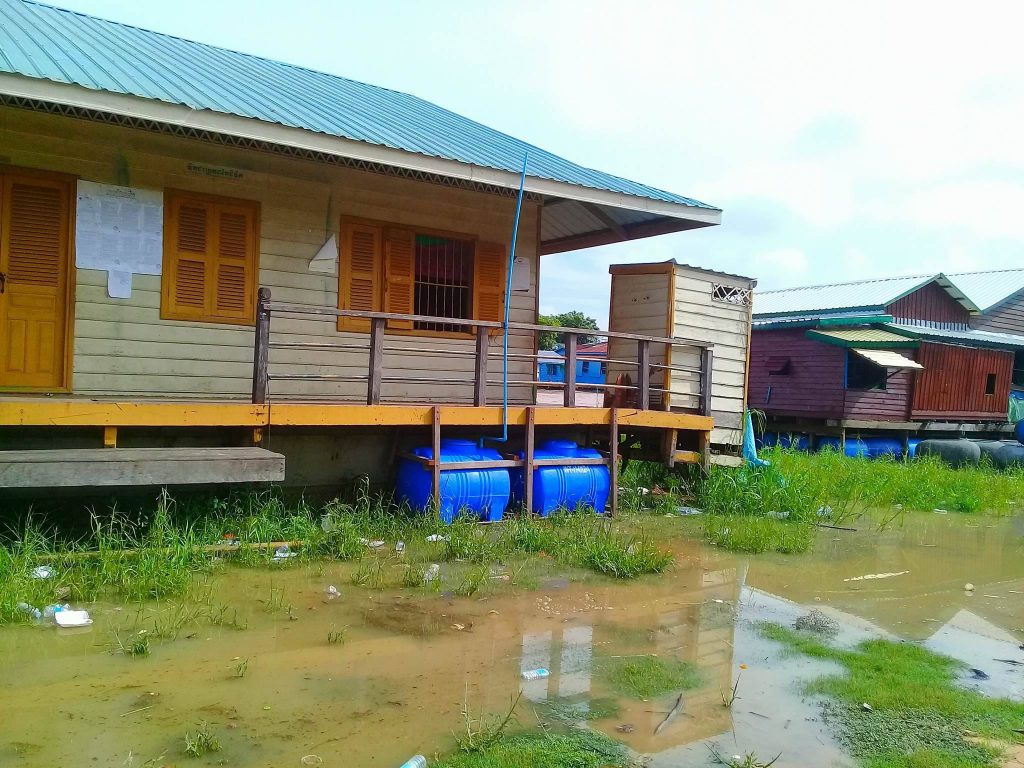
HandyPod installed on a stilted house in a flooded area near Tonle Sap Lake, Cambodia. Photo © Wetlands Work
Actions taken
In 2009, Wetlands Work (WW) set out to resolve these issues and has since become a leader in sanitation in challenging environments (SCE). Initially, the Wetlands Work team, supported by interns, students, and volunteers, set out to address pathogens and BOD in floating communities. Iterative, community-supported designs led to the development of the HandyPod, a novel treatment system currently used in villages in Cambodia and Myanmar. The HandyPod was created to provide functional sanitation in flood, floating areas, floodplains, impermeable soils, and coastal zones. Between 2009-2014 many test designs of the HandyPod were trialed in Akul Village on Tonle Sap Lake. By 2014, 35 systems were installed and led to the improved HandyPod design used today.
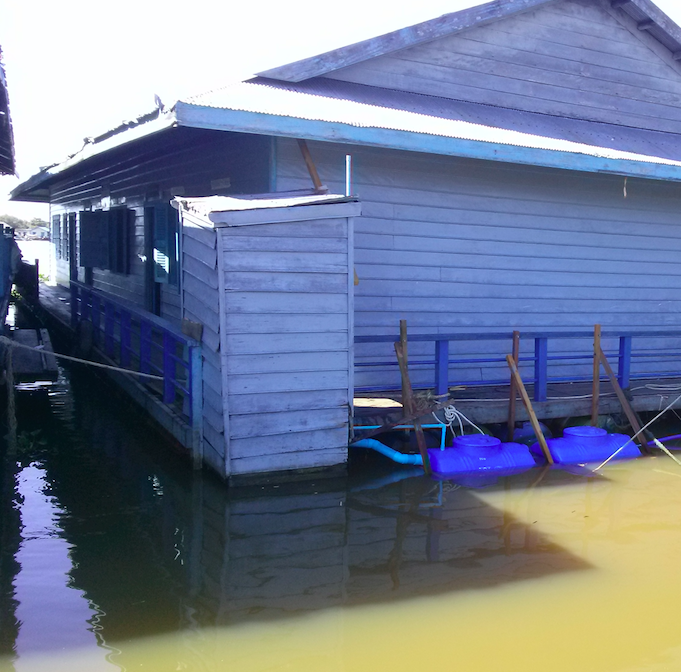
HandyPods installed on two floating schools in Tonle Sap Lake, Cambodia. Photo © Wetlands Work
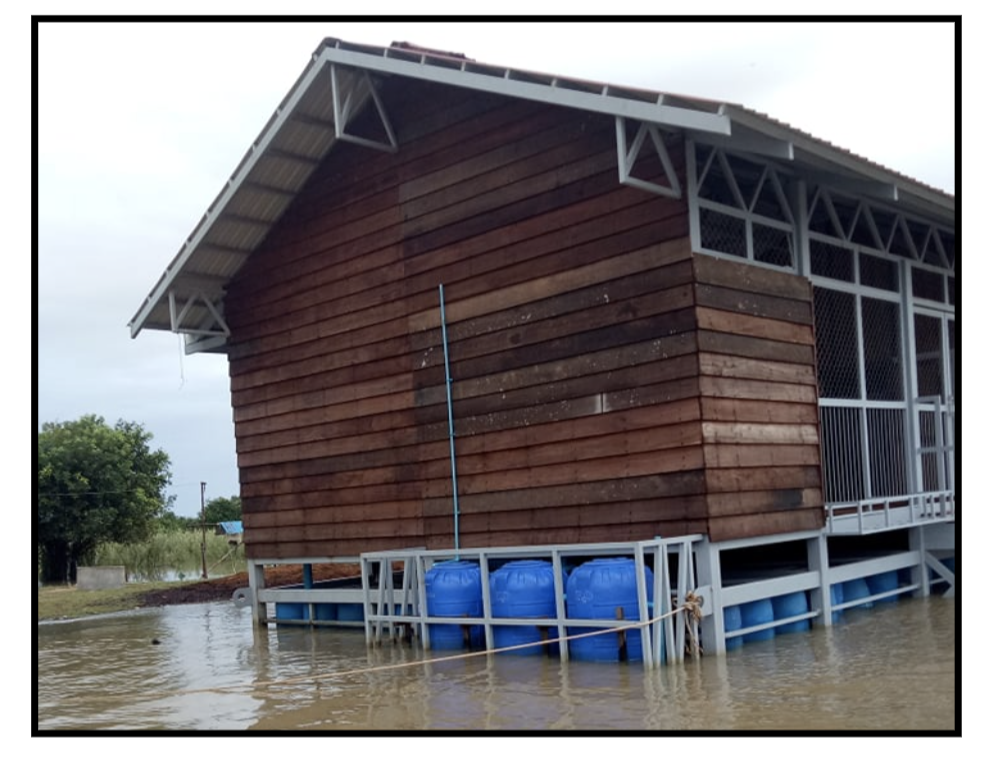
HandyPods installed on two floating schools in Tonle Sap Lake, Cambodia. Photo © Wetlands Work
Main components of the project included:
- Technical development and proof of concept efforts
- Piloting of a sanitation marketing program
- Training programs for local business operators to install HandyPods
- Community awareness efforts to create demand for sanitation
- Market-driven scaling of HandyPod distribution in the floodplain villages near Indawgyi Lake, Myanmar.
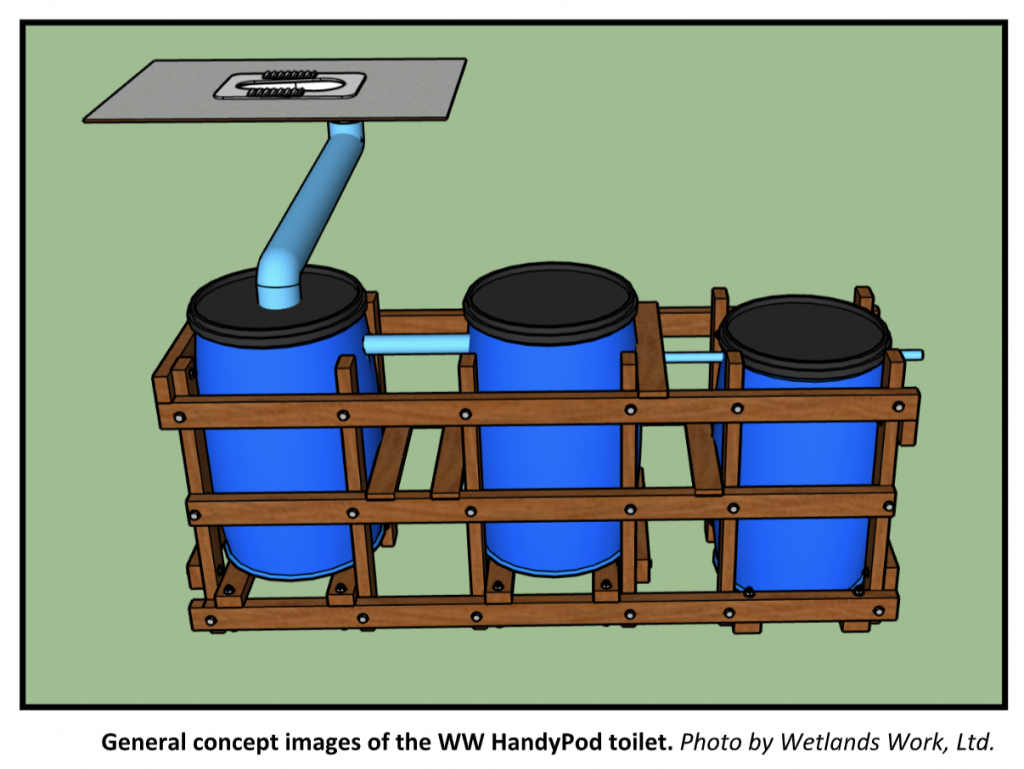
Graphic representations of the HandyPod design for floating villages. Photo © Wetlands Work
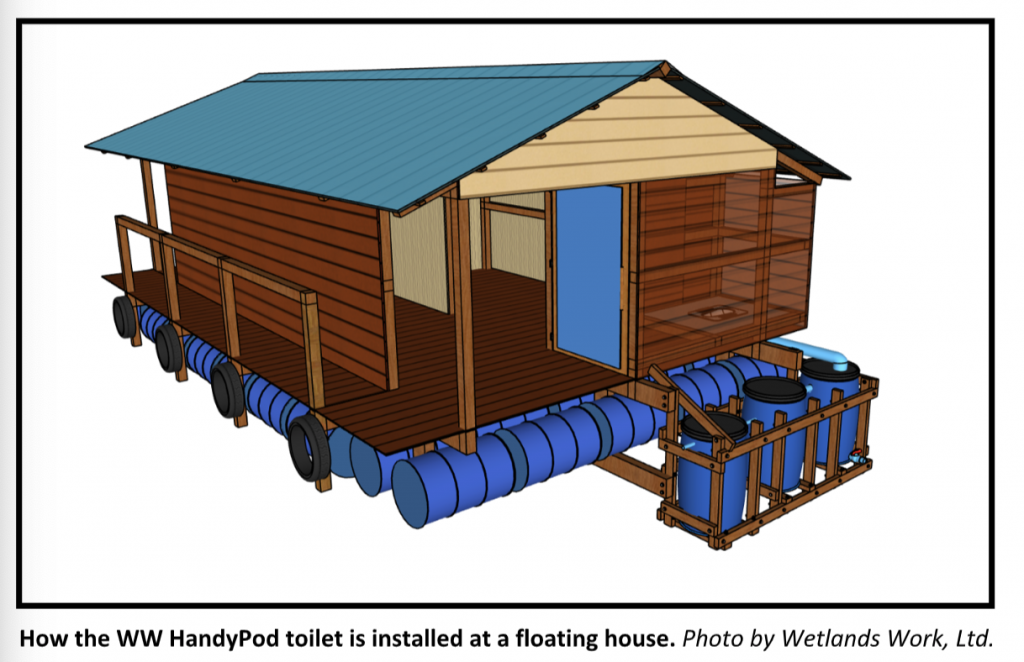
Graphic representations of the HandyPod design for floating villages. Photo © Wetlands Work
The HandyPod is low tech, simple to assemble, and easy to scale with construction and materials totaling $100-$140 per system. Three sequential treatment steps are used to remove pathogens. Flushed waste is collected in a septic container for sludge collection and partial anaerobic digestion over several days. Continued flushing pushes wastewater into a second container, which uses naturally occurring anaerobic microbes to create a biofilm to digest the waste and absorb chemicals. This microbial biofilm is the engine of the HandyPod treatment process, significantly aiding in conversion of organic chemicals to improve effluent quality.
High microbial activity in all three containers consume a diversity of pathogens so that ‘safe water’ is discharged with each pour-flush. The billions, or trillions, of E. coli pathogens per 100 mL in raw sewage are treated to yield effluent with 28-300 cfu/100 mL. this is well below the Cambodian standards for safe recreation (1,000 cfu/100 mL). Tropical temperatures are especially efficient in promoting the notable high microbial activity of the HandyPod, making this design adaptable to other challenging conditions in tropical climates.
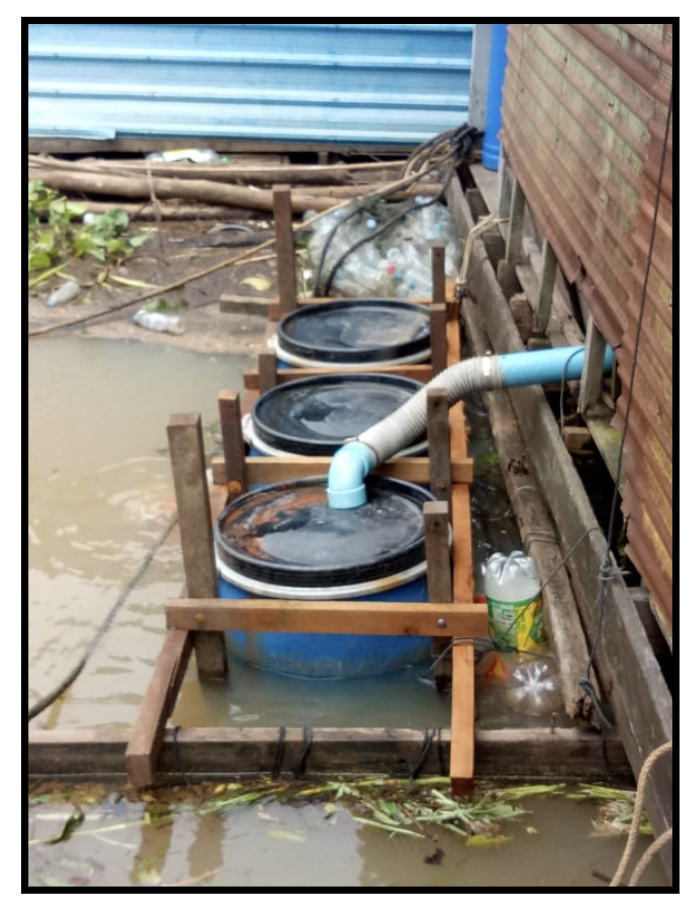
Installed HandyPods on stilted homes in floodplains. Photo © Wetlands Work
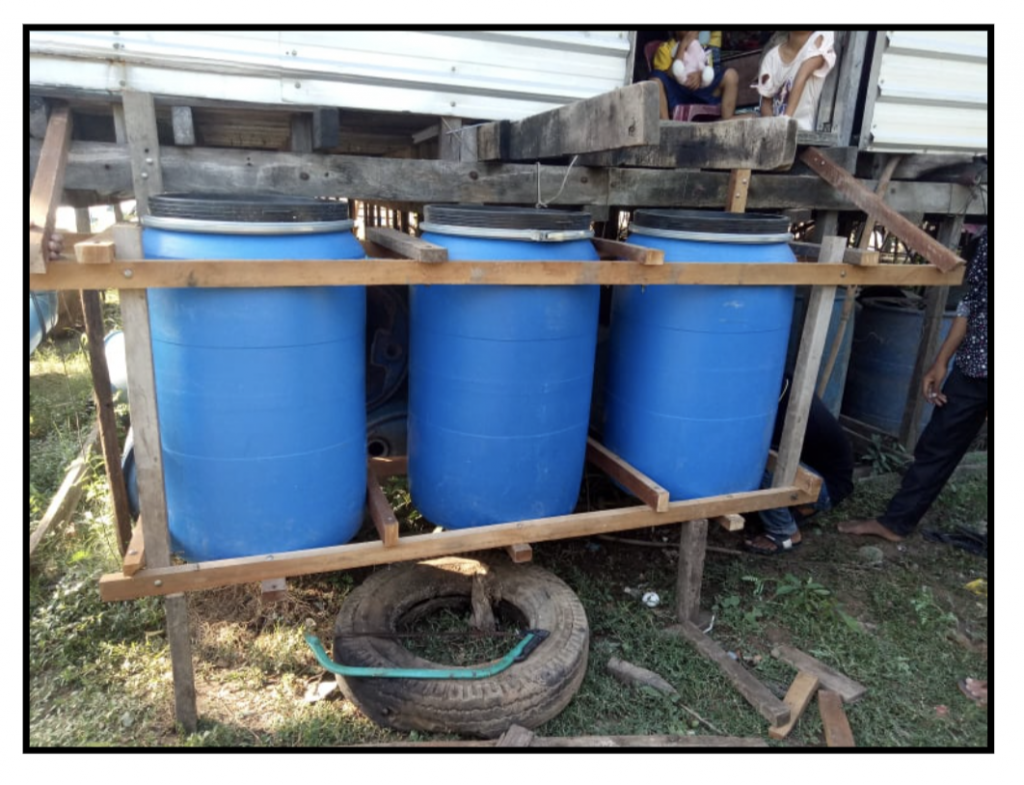
Installed HandyPods on stilted homes in floodplains. Photo © Wetlands Work
From sewage collection to fecal sludge management (FSM), the HandyPod keeps raw waste out of the lake and contributes to resource recovery by diverting urine for use as “liquid gold” fertilizer and generating a valuable solid soil supplement using shallow covered ditches in the dry season. Diverted urine, is collected and then sold to a local organic farming association, supporting a circular economy and local livelihoods while mitigating nutrient pollution and the need for synthetic fertilizers.
Wetlands Work is now endeavoring to adapt the HandyPod design for use in beach and island communities to reduce nutrient pollution. Lab research shows a 90%-95% reduction of nitrogen through sequential aeration chambers compatible with an adapted HandyPod design. Additional benefits of this effort include protection of island groundwater supplies and eliminating nutrient seepage to avoid harming sea grasses, nearshore corals, and other marine biodiversity. This design can also recover nutrients to produce aquaculture products to support island economies.
In addition to effective sanitation technology, solutions must also achieve social acceptance. Behavioral preferences and socio-economic survey information helped to improve the HandyPod design and functionality, as well as guide marketing strategies in floating villages. Community awareness about privacy, handwashing, and the importance of sanitation has been a large part of HandyPod dissemination. Community-wide raffles have educated entire villages about sanitation by offering seven HandyPods free-of-cost to introduce them to the community. Wetlands Work trains local business operators to install and maintain these systems, and identifies a leader to serve as regional guide to sustain the effort.
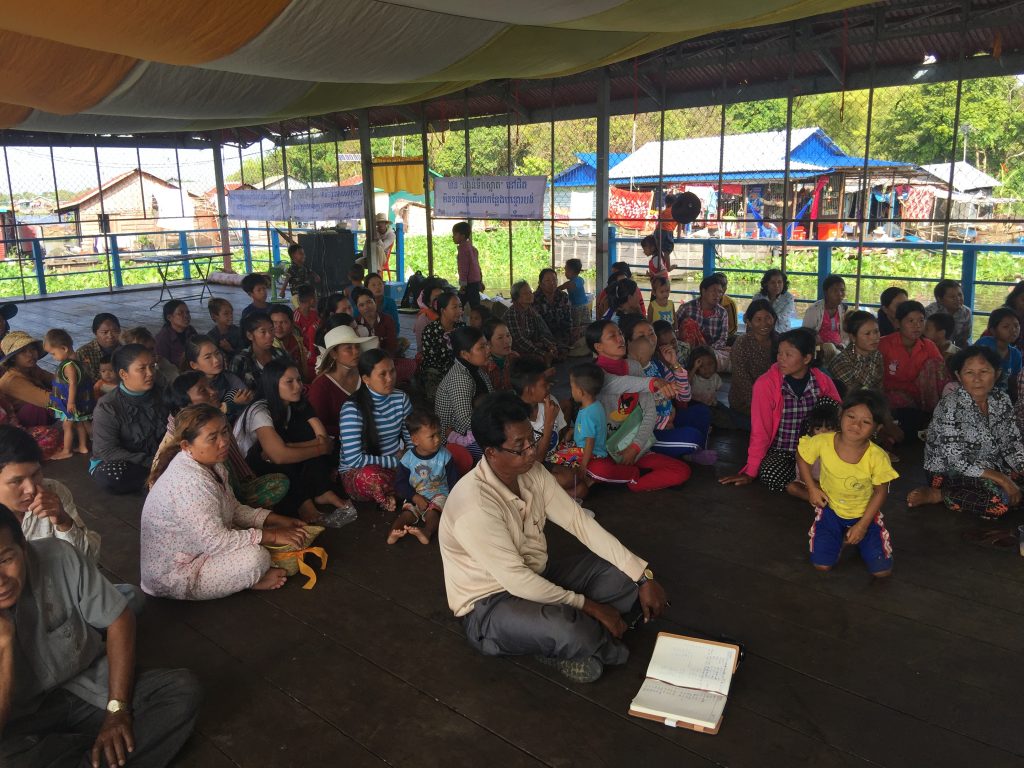
Community members attend a HandyPod raffle event put on by Wetlands Work. Photo © Wetlands Work
How successful has it been?
Based on E. coli testing by both an independent lab and WW’s own university-based lab, water discharged from the HandyPod is safe for contact and recreation. Monitoring for nutrients has been challenging, but is a priority for 2021-23. Wetlands Work expects that floating house HandyPods reduce N-loading by about 10%-15%, but the adaptation for beach environments aims to be much higher. Follow-up surveys on both lakes have found overwhelmingly positive feedback from HandyPod users. The convenience and improvement of personal privacy and dignity have been especially valuable to communities, particularly for women. The HandyPod has also become a sign of affluence and the demand for these systems is based more in social status that in health improvement. The Wetlands Work strategy of creating a market-driven solution demonstrates the importance of local economies and livelihoods in promoting HandyPod success. The result is improved sanitation, mitigated environmental contamination, and effective behavior changes.
Lessons learned and recommendations
- Floating communities are economically disadvantaged and many cannot afford the $100-$140 HandyPod. Wetlands Work will continue to collaborate with the Ministry of Rural Development and EWB Australia to establish a subsidy program for sanitation in challenging environments. This is also needed to meet Cambodia’s 2030 UN SDG 6.2 goal for 100% sanitation coverage, for which such areas remain to be addressed (globally).
- The awareness raised through the sanitation raffle event was an effective and well-received process that has created demand in communities. Winners are proud of their HandyPod, and this is a stronger marketing tool than promoting family health.
- Requiring schools and households to pay for a HandyPod and installation promotes a sense of ownership and responsibility, leading to improved system maintenance and education. Free or overly subsidized systems do not generate the same pride or care for the HandyPod.
- Keeping shelters clean, secure, and well-lit must be a priority to make people feel safe and comfortable using the HandyPod.
- Local business organizations need professional skills, support, and oversight over a period of at least 2 years to ensure a sustainable market and systems.
Funding summary
The Bill and Melinda Gates Foundation (2011-2013: $100,000 USD)
CIDA Canada Grand Challenges in Global Health Program (2015-2017: $105,000 CND)
StartSomeGood crowd funding with World Toilet Organization (2016-2017: $20,000 USD)
WaterAid Cambodia (2017: $6,000 USD)
Transparent Fish Fund (2015-2016: $8,100 USD)
EWB Australia (2017: $5,000 USD and Beach Sanitation research project 2019: $1600 USD)
SaniFlo Corp. (2016: $2,000 USD)
Wirquin Corp.(2016: $11,600 USD)
Global Sanitation Fund through Plan International w/ Cambodia Ministry of Rural Development
FSM protocol research; treatment efficiency and cost reduction research (2018: $25,000)
RELX Group Environmental Challenge Award (2018: $25,000 USD)
Darwin Initiative Award c/o Fauna & Flora International (2018-ongoing: $24,000 USD)
European Union ‘CapFish Green’ – Tonle Sap Lot I & II (2021-2025: $450,000 USD)
Lead organizations
Wetlands Work, Ltd.
WaterAid, Cambodia
Fauna & Flora International, Myanmar (Inn Chhit Tru Environment, Lake Indawgyi)
Partners
WaterAid Cambodia (CIDA grant administration and management)
Fauna & Flora International – Myanmar (Darwin Award Lead Partner, Myanmar, Indawgyi)
Floating and floodplain school sanitation projects on Tonle Sap Lake: World Toilet Organization (StartSomeGood crowd funding partner for schools)
Save the Children ECCD Program with The World Bank (Early Childhood Schools, 2019-20)
Rainwater Cambodia with UNICEF (school, 2018)
Save Cambodia Wildlife (school, 2018)
Live and Learn Environmental Education (school, 2017)
Resources
Video: Wetlands – Handy Pod
Bacteria to Improve Sanitation on Southeast Asia’s Largest Lake


